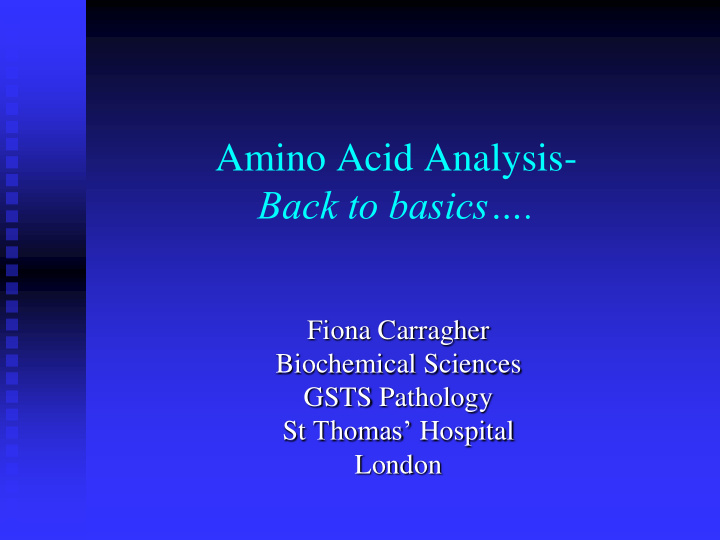



Amino Acid Analysis- Back to basics…. Fiona Carragher Biochemical Sciences GSTS Pathology St Thomas’ Hospital London
Amino acid analysis Why are amino acids important When to consider amino acid analysis Available methodology Limitations and pitfalls
Amino Acid Structure Amino group (-NH 2 ) O OH C Carboxyl group (-COOH) H N C H Distinctive R group H R
Amino Acids Essential Non-essential Phenylalanine Tyrosine Threonine Aspartate Methionine Asparagine Lysine Alanine Tryptophan Serine Leucine Glycine Isoleucine Cysteine Valine Glutamine Histidine Glutamate Proline Arginine
Amino acid disorders Clinically and biochemically heterogeneous Can present at any age Characterised by Pathological accumulation of normal metabolites Presence of non-physiological metabolites Combined incidence 1:6000
Primary amino acid disorders Phenylketonuria Urea Cycle Disorders Tyrosinaemia (I/II/III) OTC deficiency Maple Syrup Urine CPS deficiency Disease Citrullinaemia Homocystinuria Argininosuccinic Non-Ketotic aciduria Hyperglycinaemia Argininaemia Hyperprolinaemia (I/II) NAGS deficiency Sulphite oxidase def HHH OAT deficiency
Primary renal amino acid disorders Cystinuria Cystine, Ornithine, Arginine, Lysine Hartnup disease Neutral amino aciduria Lysinuric protein intolerance Lysine, Ornithine, Arginine Iminoglycinuria Proline, Hydroxyproline, Glycine
Secondary causes of increased amino acids Generalised aminoaciduria Increases in plasma Fanconi Syndrome Alanine- lactic acidaemia Galactosaemia Glutamine- hyperammmonaemia Tyrosinaemia type I Methionine/tyrosine- liver Cystinosis disease Isoleu/leu/val- ketosis Increases in urine Glycine- renal immaturity, anticonvulsant Rx
Some pitfalls to avoid Not always increased amino acids Serine deficiency Free amino acids Homocystinuria Urine homocystine not sensitive Analysis of choice is total homocysteine
When to consider amino acid analysis Neonate- Lethargy/coma/seizures/vomiting Hyperammonaemia Hypoglycaemia Ketosis Metabolic acidosis or lactic acidaemia Metabolic decompensation/encephalopathy Unexplained Liver disease Unexplained developmental delay Renal disorders- Calculi, Tubulopathy
Specific considerations Gyrate atrophy of retina Ornithine Amino Transferase deficiency Marfan-like appearance/Vascular abnormalities Homocystinuria (Cystathione B Synthase def) Hyperkeratosis Tyrosinaemia Type II
Choice of sample Plasma Most informative Often not the sample of choice by families Urine AA concentrations much more variable Prone to interference from medication Necessary for diagnosis of renal transport disorders CSF Useful in specific disorders Paired with plasma
Amino acid analysis Spot test Qualitative screening TLC HVE Quantitative analysis HPLC AAA TMS
Spot tests Ferric Chloride Reacts with a number of compounds to form a colour PKU, Tyrosinaemia, MSUD Cyanide/Nitroprusside Reacts with sulphur containing amino acids Homocystinuria, Cystinuria 2,4 Dinitrophenylhydrazine Reacts with branch-chain keto acids and phenylketones MSUD, PKU
Spot tests ADVANTAGES LIMITATIONS Cheap Prone to interference Easy Neither sensitive or specific No expensive equipment required May mislead investigations Health and safety issues
Qualitative analysis Thin Layer Chromatography 1D/2D Ninhydrin to visualise Selective staining increases number of compounds identified High Voltage Electrophoresis
Qualitative screening ADVANTAGES LIMITATIONS Cheap Significant staff time Can be used to pre-screen Technically demanding samples before referring Interpretation requires experience Does not identify all compounds of interest May only detect gross abnormalities
TLC- Maple Syrup Urine Disease
Quantitative analysis Separation of free amino acids Identification of compounds UV detection- retention time MS detection Quantitation of compounds Comparison to standards
Amino acid analyser (AAA)
Quantitative analysis- AAA ADVANTAGES LIMITATIONS Long run times Dedicated instrument Significant maintenance Specific for amino acids Will identify all Often running at capacity compounds of interest Urgent cases need rapid results
AAA- separation
AAA- Maple Syrup Urine Disease alloisoleucine
Quantitative analysis- TMS
Quantitative analysis- TMS ADVANTAGES LIMITATIONS Established in IEM field Expensive capital cost Can measure other Expertise in technology compounds of interest on required same injection Isobaric/isomeric Simple sample prep compounds require separation Rapid results Ideal for targeted screen
TMS-Maple Syrup Urine Disease
TMS- Future of routine AA analysis Rapid Commun in Mass Spec Piraud et al 19(22):3287-97 76 Amino acids detected Ion pairing reversed phase LC linked to positive electrospray MS Throughput of 2 samples per hour
TMS-Amino acid analysis 9.5e5 9.0e5 8.5e5 Aminoacid analysis by 8.0e5 MSMS (,API4000) 7.5e5 Cit, Orn, Arg, ArgS*, 7.0e5 6.5e5 ArgSanh*, Gln, Lys*, 6.0e5 Leu, Ile,Val, Gly, Ala, I n t e n s i t y , c p s 5.5e5 Met, Phe, Tyr, Creat 5.0e5 4.5e5 4.0e5 3.5e5 3.0e5 2.5e5 2.0e5 1.5e5 1.0e5 4.21 5.0e4 3.32 0.0 0.5 1.0 1.5 2.0 2.5 3.0 3.5 4.0 4.5 5.0 5.5 Time, min
Conclusion Understand the limitations of strategy State which disorders are confidently excluded In clinical emergency Rapid targeted TMS testing Good communication to specialist centre
Recommend
More recommend